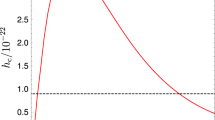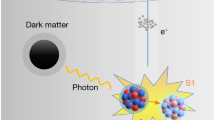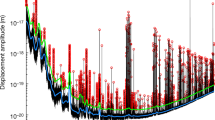Abstract
Dark matter candidates such as weakly interacting massive particles are predicted to annihilate or decay into Standard Model particles, leaving behind distinctive signatures in gamma rays, neutrinos, positrons, antiprotons, or even antinuclei. Indirect dark matter searches, and in particular those based on gamma-ray observations and cosmic-ray measurements, could detect such signatures. Here we review the strengths and limitations of this approach and look into the future of indirect dark matter searches.
This is a preview of subscription content, access via your institution
Access options
Access Nature and 54 other Nature Portfolio journals
Get Nature+, our best-value online-access subscription
$29.99 / 30 days
cancel any time
Subscribe to this journal
Receive 12 print issues and online access
$209.00 per year
only $17.42 per issue
Buy this article
- Purchase on Springer Link
- Instant access to full article PDF
Prices may be subject to local taxes which are calculated during checkout




Similar content being viewed by others
References
Bergström, L. Dark matter evidence, particle physics candidates and detection methods. Ann. Phys. 524, 479–496 (2012).
Scott, P. et al. Direct constraints on minimal supersymmetry from Fermi-LAT observations of the dwarf galaxy Segue 1. J. Cosmol. Astropart. Phys. 01, 031 (2010).
Srednicki, M., Theisen, S. & Silk, J. Cosmic quarkonium: a probe of dark matter. Phys. Rev. Lett. 56, 263–265 (1986).
Bergstrom, L. & Snellman, H. Observable monochromatic photons from cosmic photino annihilation. Phys. Rev. D 37, 3737–3741 (1988).
Hisano, J., Matsumoto, S. & Nojiri, M. M. Explosive dark matter annihilation. Phys. Rev. Lett. 92, 031303 (2004).
Navarro, J. F., Frenk, C. S. & White, S. D. M. The structure of cold dark matter halos. Astrophys. J. 462, 563–575 (1996).
Einasto, J. Kinematics and dynamics of stellar systems. Trudy Inst. Astroz. Alma-Ata 5, 87 (1965).
Moore, B., Quinn, T., Governato, F., Stadel, J. & Lake, G. Cold collapse and the core catastrophe. Mon. Not. R. Astron. Soc. 310, 1147–1152 (1999).
Burkert, A. The structure of dark matter halos in dwarf galaxies. Astrophys. J. 447, L25 (1995).
Ando, S. & Komatsu, E. Anisotropy of the cosmic gamma-ray background from dark matter annihilation. Phys. Rev. D 73, 023521 (2006).
Xia, J. Q. et al. A cross-correlation study of the Fermi-LAT γ-ray diffuse extragalactic signal. Mon. Not. R. Astron. Soc. 416, 2247–2264 (2011).
Ando, S., Benoit-Levy, A. & Komatsu, E. Mapping dark matter in the gamma-ray sky with galaxy catalogs. Phys. Rev. D 90, 023514 (2014).
Cuoco, A. et al. Dark matter searches in the gamma-ray extragalactic background via cross-correlations with galaxy catalogues. Astrophys. J. Suppl. 221, 29 (2015).
Camera, S., Fornasa, M., Fornengo, N. & Regis, M. A novel approach in the weakly interacting massive particle quest: cross-correlation of gamma-ray anisotropies and cosmic shear. Astrophys. J. Lett. 771, L5 (2013).
Shirasaki, M., Horiuchi, S. & Yoshida, N. Cross correlation of cosmic shear and extragalactic gamma-ray background: constraints on the dark matter annihilation cross section. Phys. Rev. D 90, 063502 (2014).
Hooper, D., Sarkar, S. & Taylor, A. M. The intergalactic propagation of ultra-high energy cosmic ray nuclei. Astropart. Phys. 27, 199–212 (2007).
Cuoco, A. et al. Angular signatures of annihilating dark matter in the cosmic gamma-ray background. Phys. Rev. D 77, 123518 (2008).
Ackermann, M. et al. (Fermi-LAT) Anisotropies in the diffuse gamma-ray background measured by the Fermi LAT. Phys. Rev. D 85, 083007 (2012).
Ando, S. & Komatsu, E. Constraints on the annihilation cross section of dark matter particles from anisotropies in the diffuse gamma-ray background measured with Fermi-LAT. Phys. Rev. D 87, 123539 (2013).
Fornasa, M. et al. Characterization of dark-matter-induced anisotropies in the diffuse gamma-ray background. Mon. Not. R. Astron. Soc. 429, 1529–1553 (2013).
Aharonian, F. A., Atoyan, A. M. & Voelk, H. J. High energy electrons and positrons in cosmic rays as an indicator of the existence of a nearby cosmic tevatron. A & A 294, L41 (1995).
Nishimura, J., Kobayashi, T., Komori, Y. & Yoshida, K. Observations of high energy primary electrons and their astrophysical significance. Adv. Space Res. 19, 767–770 (1997).
Kobayashi, T. et al. The most likely sources of high-energy cosmic-ray electrons in supernova remnants. Astrophys. J. 601, 340–351 (2004).
Aharonian, F. A. & Atoyan, A. M. Cosmic ray positrons connected with galactic gamma radiation of high and very high energies. J. Phys. G 17, 1769–1778 (1991).
Cirelli, M. Dark matter indirect searches: charged cosmic rays. J. Phys. Conf. Ser. 718, 022005 (2016).
Profumo, S. An observable electron-positron anisotropy cannot be generated by dark matter. J. Cosmol. Astropart. Phys. 02, 43 (2015).
Lopez, A. et al. Fermi/LAT observations of dwarf galaxies highly constrain a dark matter interpretation of excess positrons seen in AMS-02, HEAT, and PAMELA. J. Cosmol. Astropart. Phys. 03, 33 (2016).
Amenomori, M. et al. (Tibet ASγ) Large-scale sidereal anisotropy of galactic cosmic-ray intensity observed by the Tibet Air Shower Array. Astrophys. J. 626, L29 (2005).
Abdo, A. A. et al. (MILAGRO) Discovery of localized regions of excess 10-TeV cosmic rays. Phys. Rev. Lett. 101, 221101 (2008).
Aartsen, M. G. et al. (IceCube) Observation of cosmic ray anisotropy with the Icetop Air Shower Array. Astrophys. J. 765, 55 (2013).
Abeysekara, A. U. et al. (HAWC) Observation of small-scale anisotropy in the arrival direction distribution of TeV cosmic rays with HAWC. Astrophys. J. 796, 108 (2014).
Ahlers, M. & Mertsch, P. Origin of small-scale anisotropies in galactic cosmic rays. Preprint at http://arxiv.org/abs/1612.01873 (2016).
Atwood, W. B. et al. (Fermi-LAT) The Large Area Telescope on the Fermi Gamma-ray Space Telescope mission. Astrophys. J. 697, 1071–1102 (2009).
Acero, F. et al. (Fermi-LAT) Fermi Large Area Telescope Third Source Catalog. Astrophys. J. Suppl. 218, 23 (2015).
James, F. Interpretation of the shape of the likelihood function around its minimum. Comput. Phys. Commun. 20, 29–35 (1980).
Rolke, W. A., Lopez, A. M. & Conrad, J. Limits and confidence intervals in the presence of nuisance parameters. J. Nucl. Instrum. Meth. A551, 493–503 (2005).
Cowan, G., Cranmer, K., Gross, E. & Vitells, O. Asymptotic formulae for likelihood-based tests of new physics. Eur. Phys. J. C71, 1554 (2011).
Ackermann, M. et al. (Fermi-LAT) Constraining dark matter models from a combined analysis of Milky Way satellites with the Fermi Large Area Telescope. Phys. Rev. Lett. 107, 241302 (2011).
Abdallah, H. et al. (HESS Coll.) Search for dark matter annihilations towards the inner galactic halo from 10 years of observations with H.E.S.S. Phys. Rev. Lett. 117, 111301 (2016).
Conrad, J. Statistical issues in astrophysical searches for particle dark matter. Astropart. Phys. 62, 165–177 (2015).
Abdo, A. A. et al. (Fermi-LAT) Spectrum of the isotropic diffuse gamma-ray emission derived from first-year Fermi Large Area Telescope data. Phys. Rev. Lett. 104, 010101 (2010).
Ackermann, M. et al. (Fermi-LAT) Anisotropies in the diffuse gamma-ray background measured by the Fermi LAT. Phys. Rev. D 85, 083007 (2012).
Ackermann, M. et al. (Fermi-LAT) Updated search for spectral lines from Galactic dark matter interactions with pass 8 data from the Fermi Large Area Telescope. Phys. Rev. D 91, 122002 (2015).
Abramowski, A. et al. (HESS Coll.) Search for photon-linelike signatures from dark matter annihilations with H.E.S.S. Phys. Rev. Lett. 110, 041301 (2013).
Abramowski, A. et al. (HESS Coll.) Constraints on an annihilation signal from a core of constant dark matter density around the Milky Way Center with H.E.S.S. Phys. Rev. Lett. 114, 081301 (2015).
Goodenough, L. & Hooper, D. Possible evidence for dark matter annihilation in the inner Milky Way from the Fermi Gamma Ray Space Telescope. Preprint at http://arxiv.org/abs/0910.2998 (2009).
Hooper, D. & Goodenough, L. Dark matter annihilation in the galactic center as seen by the Fermi Gamma Ray Space Telescope. Phys. Lett. B 697, 412–428 (2011).
Hooper, D. & Slatyer, T. R. Two emission mechanisms in the Fermi bubbles: a possible signal of annihilating dark matter. Phys. Dark Univ. 2, 118–138 (2013).
Daylan, T. et al. The characterization of the gamma-ray signal from the central Milky Way: a case for annihilating dark matter. Phys. Dark Univ. 12, 1–23 (2016).
Abazajian, K. N. & Kaplinghat, M. Detection of a gamma-ray source in the Galactic Center consistent with extended emission from dark matter annihilation and concentrated astrophysical emission. Phys. Rev. D 86, 083511 (2012).
Calore, F. et al. A tale of tails: dark matter interpretations of the Fermi GeV excess in light of background model systematics. Phys. Rev. D 91, 063003 (2015).
Gordon, C. & Macías, O. Dark matter and pulsar model constraints from Galactic Center Fermi-LAT gamma-ray observations. Phys. Rev. D 88, 083521 (2013).
Calore, F. et al. The Fermi GeV excess: challenges for the dark matter interpretation. J. Phys. Conf. Ser. 718, 042010 (2016).
Ajello, M. (Fermi-LAT) Fermi-LAT observations of high-energy gamma-ray emission toward the galactic center. Astrophys. J. 819, 44 (2016).
Yang, R. & Aharonian, F. On the GeV excess in the diffuse γ-ray emission towards the Galactic Center. A & A 589, A117 (2016).
Macias, O. et al. Discovery of gamma-ray emission from the x-shaped bulge of the Milky Way. Preprint at http://arXiv.org/abs/1611.06644 (2016).
Cholis, I., Hooper, D. & Linden, T. Challenges in explaining the Galactic Center gamma-ray excess with millisecond pulsars. J. Cosmol. Astropart. Phys. 06, 043 (2015).
Stecker, F. W. The cosmic γ-ray spectrum from secondary particle production in cosmic-ray interactions. Astrophys. Space Sci. 6, 377–389 (1970).
Bertsch, D. L. et al. Diffuse gamma-ray emission in the galactic plane from cosmic-ray, matter, and photon interactions. Astrophys. J. 416, 587–600 (1993).
Strong, A. W., Moskalenko, I. V. & Reimer, O. Diffuse continuum gamma rays from the Galaxy. Astrophys. J. 537, 763–784 (2000).
Ackermann, M. et al. (Fermi-LAT) Constraints on the galactic halo dark matter from Fermi-LAT diffuse measurements. Astrophys. J. 761, 91 (2012).
Ullio, P. & Valli, M. A critical reassessment of particle dark matter limits from dwarf satellites. J. Cosmol. Astropart. Phys. 07, 025 (2016).
Ackermann, M. et al. (Fermi-LAT) Search for gamma-ray emission from the Coma Cluster with six years of Fermi-LAT data. Astrophys. J. 819, 149 (2016).
Ackermann, M. et al. (Fermi-LAT) Search for extended gamma-ray emission from the Virgo galaxy cluster with Fermi-LAT. Astrophys. J. 812, 159 (2016).
Ahnen, M. L. et al. (MAGIC Coll.) Deep observation of the NGC 1275 region with MAGIC: search of diffuse γ-ray emission from cosmic rays in the Perseus cluster. A & A 589, A33 (2016).
Ackermann, M. et al. (Fermi-LAT) Search for cosmic-ray induced gamma-ray emission in galaxy clusters. Astrophys. J. 787, 18 (2014).
Ackermann, M. et al. (Fermi-LAT Coll) The spectrum of isotropic diffuse gamma-ray emission between 100 MeV and 820 GeV. Astrophys. J. 799, 86 (2015).
Sreekumar, P. et al. EGRET observations of the extragalactic gamma ray emission. Astrophys. J. 494, 523–534 (1998).
Keshet, U., Waxman, E. & Loeb, A. The case for a low extragalactic gamma-ray background. J. Cosmol. Astropart. Phys. 4, 006 (2004).
Strong, A. W., Moskalenko, I. V. & Reimer, O. A new determination of the extragalactic diffuse gamma-ray background from EGRET data. Astrophys. J. 613, 956–961 (2004).
Abdo, A. A. et al. (Fermi-LAT) Spectrum of the isotropic diffuse gamma-ray emission derived from first-year Fermi Large Area Telescope data. Phys. Rev. Lett. 104, 101101 (2010).
Siegal-Gaskins, J. M. et al. Anisotropies in the gamma-ray sky from millisecond pulsars. Mon. Not. R. Astron. Soc. 415, 1074–1082 (2011).
Ajello, M. et al. (Fermi-LAT) The origin of the extragalactic gamma-ray background and implications for dark matter annihilation. APJ 800, L27 (2015).
Di Mauro, M. & Donato, F. Composition of the Fermi-LAT isotropic gamma-ray background intensity: emission from extragalactic point sources and dark matter annihilations. Phys. Rev. D 91, 123001 (2015).
Ullio, P. et al. Cosmological dark matter annihilations into γ rays: a closer look. Phys. Rev. D 66, 123502 (2002).
Fornasa, M. & Sanchez-Conde, M. The nature of the diffuse gamma-ray background. Phys. Rep. 598, 1–58 (2015).
Adriani, O. et al. (PAMELA Coll.) An anomalous positron abundance in cosmic rays with energies 1.5–100 GeV. Nature 458, 607–609 (2009).
Aguilar, M. (AMS Coll.) Electron and positron fluxes in primary cosmic rays measured with the Alpha Magnetic Spectrometer on the International Space Station. Phys. Rev. Lett. 113, 121102 (2014).
Aguilar, M. et al. (AMS Coll.) Antiproton flux, antiproton-to-proton flux ratio, and properties of elementary particle fluxes in primary cosmic rays measured with the Alpha Magnetic Spectrometer on the International Space Station. Phys. Rev. Lett. 117, 091103 (2016).
Ackermann, M. et al. (Fermi-LAT Coll.) Searching for dark matter annihilation from Milky Way dwarf spheroidal galaxies with six years of Fermi Large Area Telescope data. Phys. Rev. Lett. 115, 231301 (2015).
Giesen, G. et al. AMS-02 antiprotons, at last! Secondary astrophysical component and immediate implications for dark matter. J. Cosmol. Astropart. Phys. 09, 023 (2015).
Jin, H. B., Wu, Y. L. & Zhou, Y. F. Upper limits on dark matter annihilation cross sections from the first AMS-02 antiproton data. Phys. Rev. D 92, 055027 (2015).
Kaplan, D. E., Luty, M. A. & Zurek, K. M. Asymmetric dark matter. Phys. Rev. D 79, 115016 (2009).
Bechtol, K. et al. (DES Collaboration) Eight new Milky Way companions discovered in first-year Dark Energy Survey data. Astrophys. J. 807, 50 (2015).
Drlica-Wagner, A. et al. (DES Collaboration) Eight ultra-faint galaxy candidates discovered in year two of the Dark Energy Survey. Astrophys. J. 813, 109 (2015).
Laevens, B. P. M. et al. Sagittarius II, Draco II and Laevens 3: three new Milky Way satellites discovered in the Pan-STARRS 1 3pi Survey. Astrophys. J. 813, 44 (2015).
Drlica-Wagner, A. et al. (DES Collaboration) Search for gamma-ray emission from DES dwarf spheroidal galaxy candidates with Fermi-LAT data. Astrophys. J. 809, L4 (2015).
Albert, A. et al. (Fermi-LAT, DES Collaborations) Searching for dark matter annihilation in recently discovered Milky Way satellites with Fermi-LAT. Astrophys. J. 834, 110 (2017).
Dalal, N. & Kochanek, C. S. Direct detection of CDM substructure. Astrophys. J. 572, 25–33 (2002).
Perryman, M.A. C. et al. GAIA: composition, formation and evolution of the Galaxy. A & A 369, 339–363 (2001).
Chahill-Rawley, M. et al. Complementarity of dark matter searches in the phenomenological MSSM. Phys. Rev. D 91, 055011 (2015).
Peccei, R. D. & Quinn, H. R. CP conservation in the presence of pseudoparticles. Phys. Rev. Lett. 38, 1440–1443 (1997).
Weinberg, S. A new light boson? Phys. Rev. Lett. 40, 223–226 (1978).
Wilczek, F. Problem of strong P and T invariance in the presence of instantons. Phys. Rev. Lett. 40, 279–282 (1978).
Ajello, M. et al. (Fermi-LAT) Search for spectral irregularities due to photon–axionlike-particle oscillations with the Fermi Large Area Telescope. Phys. Rev. Lett. 116, 161101 (2016).
Meyer, M. et al. Fermi Large Area Telescope as a galactic supernovae axionscope. Phys. Rev. Lett. 118, 011103 (2017).
Park, E.-K. DMSAG Report on the Direct Detection and Study of Dark Matter (2007); https://science.energy.gov/∼/media/hep/pdf/files/pdfs/dmsagreportjuly18_2007.pdf
Pieri, L. et al. Implications of high-resolution simulations on indirect dark matter searches. Phys. Rev. D 83, 023518 (2011).
Ade, P. A. R. et al. (Planck Coll.) Planck 2015 results XIII. Cosmological parameters. A & A 594, A13 (2016).
Adrian-Martinez, S. et al. (ANTARES Coll.) Limits on dark matter annihilation in the sun using the ANTARES neutrino telescope. Phys. Lett. B 759, 69–74 (2016).
Aartsen, M. G. et al. (IceCube Coll.) All-flavour search for neutrinos from dark matter annihilations in the Milky Way with IceCube/DeepCore. Eur. Phys. J. C 76, 531 (2016).
Gordon, C. & Macias, O. Dark matter and pulsar model constraints from Galactic Center Fermi-LAT gamma-ray observations. Phys. Rev. D 88, 083521 (2013).
Daylan, T. et al. The characterization of the gamma-ray signal from the central Milky Way: a case for annihilating dark matter. Phys. Dark Univ. 12, 1–23 (2016).
Calore, F., Cholis, I. & Weniger, C. Background model systematics for the Fermi GeV excess. J. Cosmol. Astropart. Phys. 1503, 038 (2015).
Aprile, E. et al. (XENON Collaboration) Physics reach of the XENON1T Dark Matter Experiment. J. Cosmol. Astropart. Phys. 04, 027 (2016).
Akerib, D. S. et al. (LZ Collaboration) LUX-ZEPLIN (LZ) Conceptual Design Report. Preprint at http://arXiv.org/abs/1509.02910 (2015).
Acknowledgements
J.C. is a Wallenberg Academy Fellow.
Author information
Authors and Affiliations
Corresponding author
Ethics declarations
Competing interests
The authors declare no competing financial interests.
Rights and permissions
About this article
Cite this article
Conrad, J., Reimer, O. Indirect dark matter searches in gamma and cosmic rays. Nature Phys 13, 224–231 (2017). https://doi.org/10.1038/nphys4049
Received:
Accepted:
Published:
Issue Date:
DOI: https://doi.org/10.1038/nphys4049
This article is cited by
-
High precision particle astrophysics as a new window on the universe with an Antimatter Large Acceptance Detector In Orbit (ALADInO)
Experimental Astronomy (2021)
-
A single atom noise probe operating beyond the Heisenberg limit
npj Quantum Information (2020)
-
Generalized statistical mechanics of cosmic rays: Application to positron-electron spectral indices
Scientific Reports (2018)



